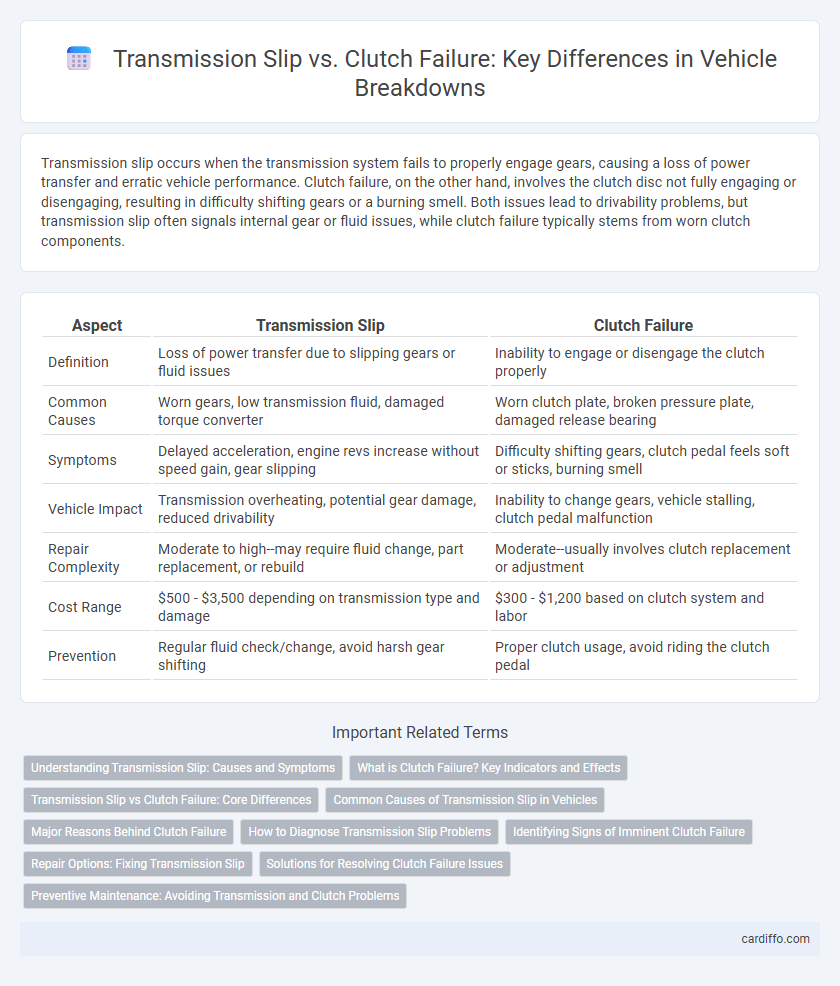Transmission slip occurs when the transmission system fails to properly engage gears, causing a loss of power transfer and erratic vehicle performance. Clutch failure, on the other hand, involves the clutch disc not fully engaging or disengaging, resulting in difficulty shifting gears or a burning smell. Both issues lead to drivability problems, but transmission slip often signals internal gear or fluid issues, while clutch failure typically stems from worn clutch components.
Table of Comparison
| Aspect | Transmission Slip | Clutch Failure |
|---|---|---|
| Definition | Loss of power transfer due to slipping gears or fluid issues | Inability to engage or disengage the clutch properly |
| Common Causes | Worn gears, low transmission fluid, damaged torque converter | Worn clutch plate, broken pressure plate, damaged release bearing |
| Symptoms | Delayed acceleration, engine revs increase without speed gain, gear slipping | Difficulty shifting gears, clutch pedal feels soft or sticks, burning smell |
| Vehicle Impact | Transmission overheating, potential gear damage, reduced drivability | Inability to change gears, vehicle stalling, clutch pedal malfunction |
| Repair Complexity | Moderate to high--may require fluid change, part replacement, or rebuild | Moderate--usually involves clutch replacement or adjustment |
| Cost Range | $500 - $3,500 depending on transmission type and damage | $300 - $1,200 based on clutch system and labor |
| Prevention | Regular fluid check/change, avoid harsh gear shifting | Proper clutch usage, avoid riding the clutch pedal |
Understanding Transmission Slip: Causes and Symptoms
Transmission slip occurs when the transmission fails to effectively transfer engine power to the wheels, often caused by worn friction materials, low transmission fluid, or damaged gears. Symptoms include delayed acceleration, engine revving without corresponding speed increase, and inconsistent shifting patterns. Recognizing these signs early can prevent severe clutch failure and costly repairs.
What is Clutch Failure? Key Indicators and Effects
Clutch failure occurs when the clutch system in a vehicle stops transmitting power efficiently from the engine to the transmission, often due to worn-out friction material or hydraulic issues. Key indicators include a burning smell, difficulty shifting gears, and slipping during acceleration. Effects of clutch failure range from reduced vehicle performance and increased fuel consumption to complete inability to engage gears, leading to breakdown.
Transmission Slip vs Clutch Failure: Core Differences
Transmission slip occurs when the transmission gears fail to engage properly, causing a loss of power and erratic shifting, often due to worn-out clutch plates or low transmission fluid. Clutch failure involves the clutch disc failing to disengage or engage smoothly, resulting in difficulty changing gears, excessive pedal effort, or a burning smell, commonly caused by worn friction material or hydraulic issues. Understanding these core differences helps diagnose whether the problem lies within the transmission system or the clutch assembly, essential for targeted repairs.
Common Causes of Transmission Slip in Vehicles
Transmission slip in vehicles commonly results from worn or damaged clutch plates, low transmission fluid levels, or contaminated fluid causing inadequate hydraulic pressure. Faulty or stretched transmission bands and solenoids can also contribute to slip by disrupting the engagement of gears. Regular maintenance, including fluid changes and inspections, is essential to prevent transmission slip and avoid costly clutch failure.
Major Reasons Behind Clutch Failure
Clutch failure frequently stems from excessive heat caused by slipping, often due to improper clutch adjustment or worn friction materials. Another major reason includes hydraulic system leaks or air in the clutch lines, which impair clutch engagement and lead to premature wear. Frequent stop-and-go driving and harsh driving habits accelerate clutch plate deterioration, resulting in transmission slip and overall clutch malfunction.
How to Diagnose Transmission Slip Problems
Diagnosing transmission slip problems involves checking for delayed or erratic gear engagement and unusual engine RPM increases without corresponding acceleration. Perform a road test to observe if the transmission slips during acceleration or while shifting gears, and inspect the transmission fluid for color, level, and odor changes indicating internal damage. Utilizing diagnostic tools to read transmission error codes can pinpoint issues related to solenoids, clutches, or valve bodies contributing to transmission slip.
Identifying Signs of Imminent Clutch Failure
Transmission slip often manifests as a delay or lack of power transfer between the engine and wheels, while clutch failure specifically shows symptoms such as a burning smell, difficulty shifting gears, and a spongy or sticking clutch pedal. Identifying signs of imminent clutch failure includes noticing increased engine revs without acceleration, unusual noises when shifting, and a clutch pedal that engages too high or low. Early detection through these indicators can prevent extensive damage to the vehicle's transmission system.
Repair Options: Fixing Transmission Slip
Fixing transmission slip involves diagnosing worn or damaged components such as the transmission bands, clutches, or fluid issues to restore proper gear engagement. Repair options include replacing worn clutch packs, adjusting band tensions, or performing a complete transmission rebuild for severe damage. Regular maintenance with high-quality transmission fluid also helps prevent slip and extends transmission lifespan.
Solutions for Resolving Clutch Failure Issues
Addressing clutch failure begins with inspecting and replacing worn clutch plates and pressure plates to restore proper engagement and prevent transmission slip. Hydraulic system maintenance, including checking clutch fluid levels and bleeding air from the system, ensures smooth clutch operation and responsiveness. Regular adjustments of the clutch cable and timely replacement of faulty release bearings significantly reduce the risk of clutch failure and improve overall vehicle performance.
Preventive Maintenance: Avoiding Transmission and Clutch Problems
Regular inspection and maintenance of transmission fluid levels and clutch components significantly reduce the risk of transmission slip and clutch failure. Monitoring for early signs such as unusual noises, delayed gear engagement, or a burning smell helps identify issues before they escalate. Implementing timely adjustments and fluid replacements extends the lifespan of both transmission and clutch systems, ensuring optimal vehicle performance.
Transmission slip vs clutch failure Infographic

 cardiffo.com
cardiffo.com